The Nodder Exchange - Bobbing Head Repair Guide
(Must Reading for any serious Nodder Collector)

Why do I make such a fuss about repaired dolls? Here's a true story, one that happens all the time..
1. An Ebay "dealer" buys a bunch of crappy dolls for a song. Here are the actual pictures.

2. Dealer sends the dolls to a master repair artist to have them fixed. Remember this is a true story, the repairer actually sent me these pictures along with the story. Here is the finished product. Pretty amazing work!
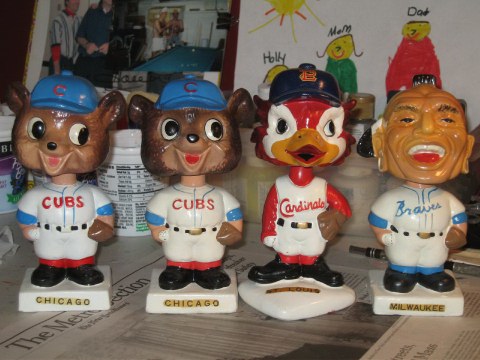
3. Dealer gets the dolls back. Puts the first Cub on EBay, sells it for $415. By the way, it slipped his mind that he just had it restored, here's the actual description - "Original vintage 1961-1963 Chicago Cubs white square base nodder. This is the very first nodder ever produced of the Chicago Cubs featuring the mascot head. In near perfect condition the only flaw is a small paint chip on the right arm sleeve and on the right side of the base, both are probably factory flaws. All original about as nice as they come." Here's his pic as it appeared on EBay.
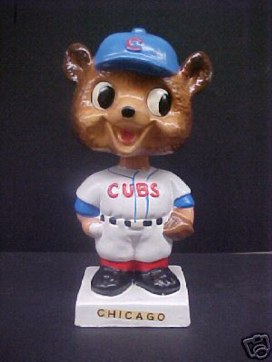
4. Dealer makes a huge profit, collector has a restored doll in his collection that he paid a mint price for. The same guy has had another dozen repaired dolls on since this one sold, most with similar results... Welcome to the seedier side of Bobbing Head Collecting.
I don't know about you, but this really ticks me off!! It's a great hobby but guys like this are trying to destroy it, just so they can make a quick buck..
Let me state here that "there is absolutely nothing wrong with selling, buying or owning a restored doll". I regularly have many restored dolls in my auctions and sales and they do very, very well. Many collectors would much prefer a doll that has been restored and looks super as compared to a banged up doll.
Prices on restored dolls have gone up dramatically in the last several years to the point where a restored gem mint looking doll now often meets or exceeds prices of nice NrMt examples. Had the Cubs doll shown earlier come to me, I would have advertised it honestly as a restored doll that looks gem minty and it probably would have done quite well. Maybe $415 , maybe less, but the winner would have known exactly what they were getting.
In an effort to help you recognize restored dolls I have designed this guide. Read it over, check out the pictures and let me know if you have any suggestions or things to add. Restored dolls are great, as long as you know..
5. Do's and Don'ts (Please read!!!)
Generally considered the most minor of alterations. Paint touchups can range from a tiny pinpoint nick that is filled in with paint or marker to light repaints of areas that have gotten scraped or nicked up.
If done well, touch ups are very, very difficult to detect with the naked eye. There is such a variety of paint colors available that most can be matched almost identically by a skilled artist.
Examine closely for areas of dolls where the paint does not match exactly.

Also look for areas of the doll that appear to have a nick or dent in the mold but the colors match and there is no white showing. Often occurs on edges or high points, such as a corner of a base, brim of hat, tip of feather, etc. Shoulders are another thing to watch for.
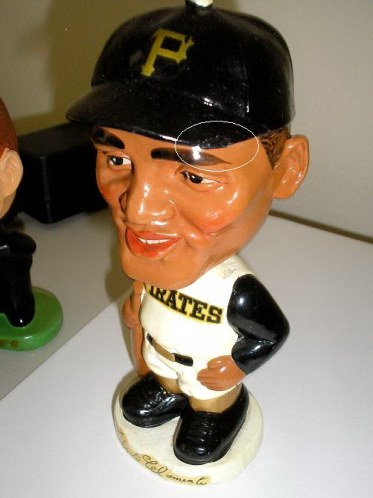
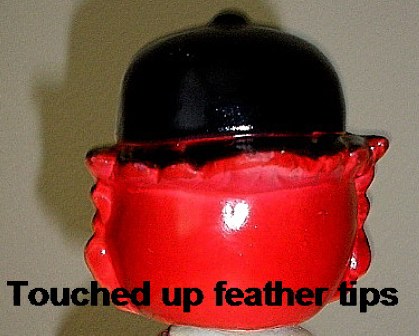
What a Black Light will show-
You can almost always spot isolated touch ups with a black light. On an original doll, the doll’s paint will absorb the light, it almost appears that you are seeing “into the doll“, a bit like an ex ray. If something more recent has been added, the newer paint will reflect the light back at you causing it to look dark and shiny.
Practice - Get a beat up doll and try touching up a few small areas. Darken the lights and turn on your black light. You should be able to easily see the places that you touched up, they will reflect the light and glow back at you.
Generally, repairs are cracks or larger chips that have had material added to fill them in, smoothed over and then repainted to match the rest of the doll. Repairs can be anywhere, hat , face, head rim, feet, neck, etc.
Some home made repairs are easy to spot. Often the mold is slightly lumpy or the paint does not match perfectly. Professionally done repairs are very, very difficult to spot with the naked eye.
Look for head rims that are either “too lumpy“ , “too smooth” or “too sharp”. Most rims, even on mint dolls will have some degree of roughness. If you see a rim that is perfectly smooth and the paint is even throughout, there's a good chance that it's had some work done.
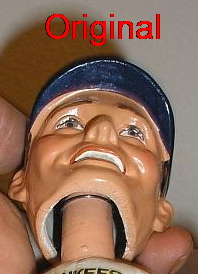
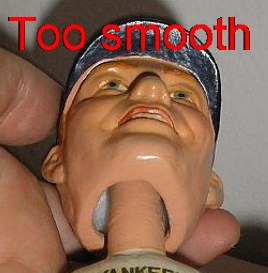
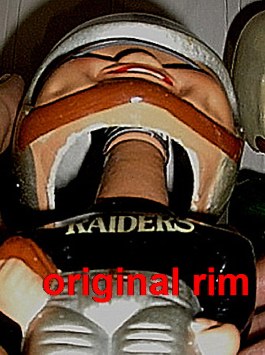
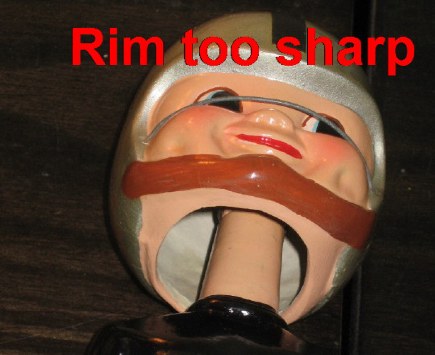
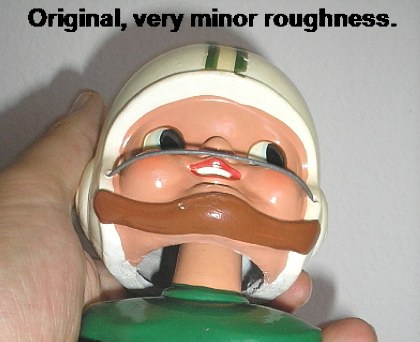

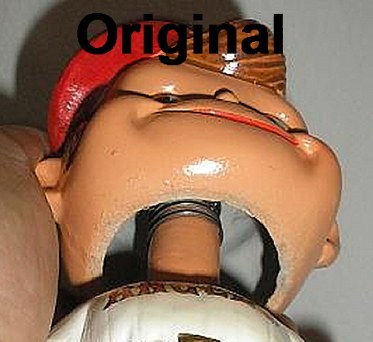
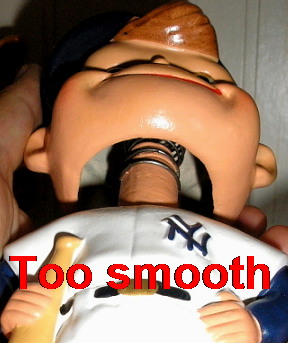

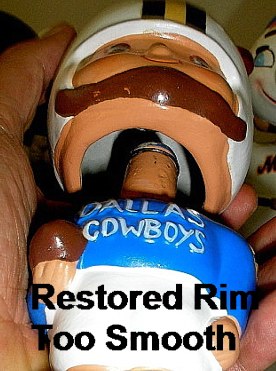
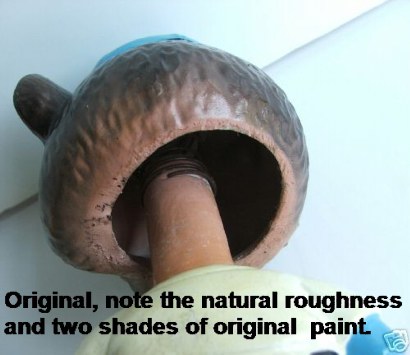
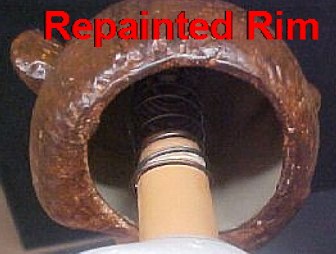
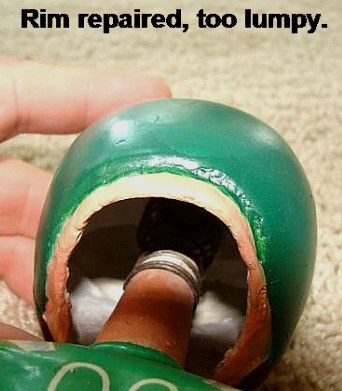

What a Black Light will show- Shine a black light on the rim area. On an original doll, the paint around the rim will absorb the light, it almost appears that you are seeing “into the doll“, a bit like an ex ray. If the rim area has been repaired you'll see strong reflections in that area causing it to look dark and shiny. It's easy to spot isolated repairs to the rim, the contrast between the repaired rim area and the rest of the original head will be clearly evident. It's a bit more difficult if the whole doll has been redone. (More on that later..)
Most cracking and subsequent repairs are to the head area. In addition to examining the rim, check the heads or helmets for signs of repainting (if a crack is repaired, the head will have to be repainted). On football helmets check for coloring as well as brush strokes, on an original paint job you will rarely see the brush strokes. Often you can tell that a doll has been repainted by the coloring. In the examples below the reds, oranges and golds are all off a bit which would be evident to those of you that are familiar with what they should look like.
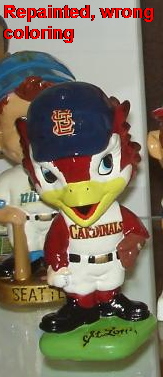
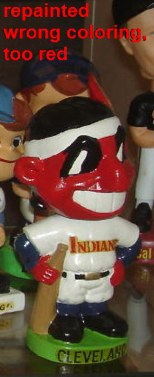
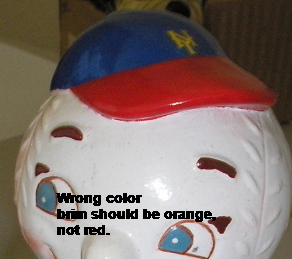

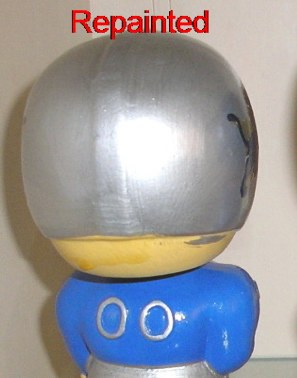
If you see a picture of a doll for sale and the face looks a little strange (sort of blurry), beware. Dolls that have had cracks to the faces are hard to repair perfectly except for the real professional. The result is often a fuzzy look, the skin is not quite smooth and the paint can be a bit thick in places. Also check the eyes. Often cracks reached the eye area and they are very tough to recreate perfectly. If the eyes look weird or they look glassy like mine do on certain Sunday mornings it may be a tipoff.
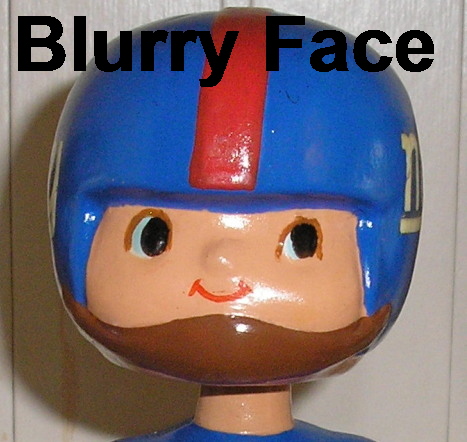

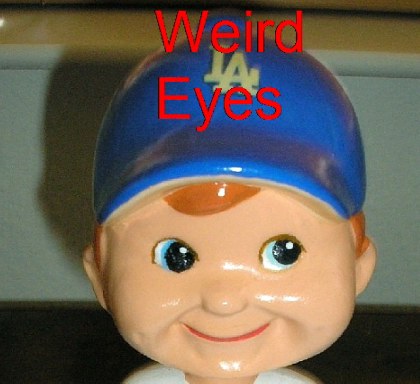
Here's a comparison: Giants doll in the middle looks "fuzzy", other two original dolls have much clearer faces. The left eye on the Giants is a bit "weird" too.
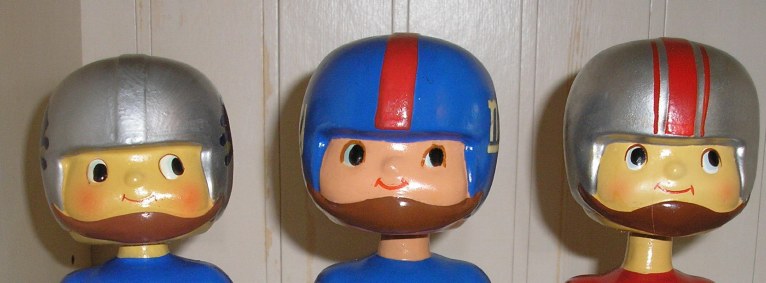
What a Black Light will show - If I used my black light on the 3 dolls above, the Lion and 49'er faces would "absorb the light" and look nice and clear while the Giant face would reflect back a dark purplish coloring. Very easy to spot as a comparison. Likewise, with repainted hats, feathers, helmets, etc the newly added paint will reflect the light while original paint will absorb it.
Look inside the head and around the rim. While many expert restorers clean up the inside of heads, many others do not. If you see added material inside the head its quite possible that the doll has been repaired. Also look for cracks inside the head without a corresponding crack on the outside, if you see that it's probable that some work has been done.
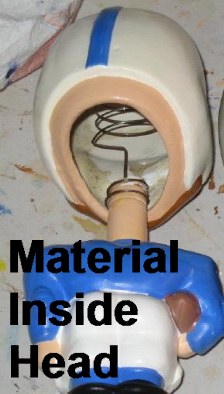
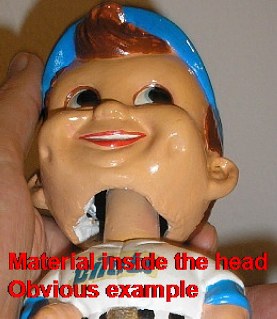
Houston doll below "TON" was added. Very nice job but you could spot it in the pictures if you examine it closely.
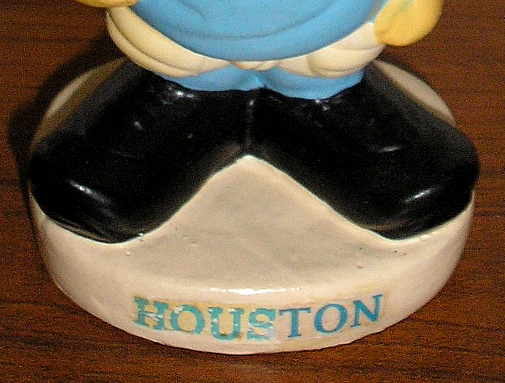
Might be hard to tell from the picture, but the chest decal has been enhanced with a marker.
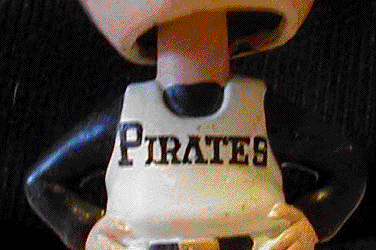
Note the Braves doll below. Embossed logo was damaged, it has been enhanced on the
restored version :


Below on the left is a generic Toes Up dolls with completely fake decals. Instantly changes it from a $40 doll to a $315 doll on EBay. On the right is what a real Japan College decal looks like... For $15 a collector can subscribe to www.NodderPriceGuide.com and see pictures of almost every College doll made. Had the lucky winner of the above doll checked out my price guide he could have saved himself $ !!!!!

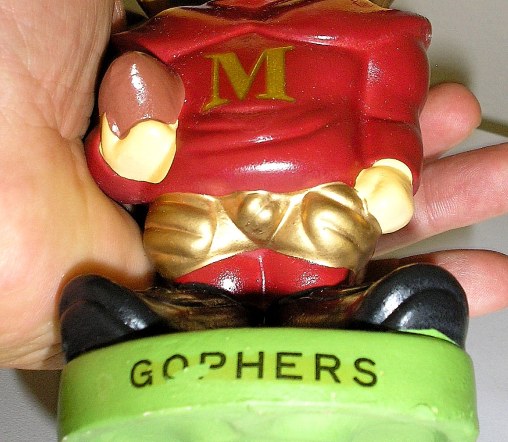
Here's another fake. Decals all wrong, Notre Dame colors aren't even correct! The picture of the real Notre Dame doll was taken directly from www.NodderPriceguide.com.
Fake Real
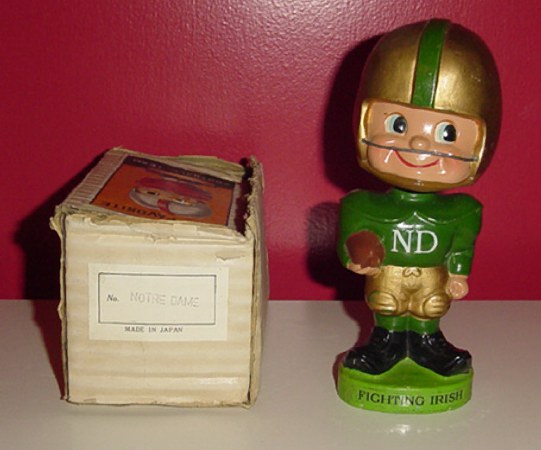
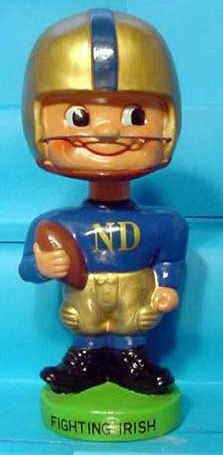
This would make me laugh and I wouldn't even include it here if some poor guy hadn't paid $228 on EBay for this the other day...
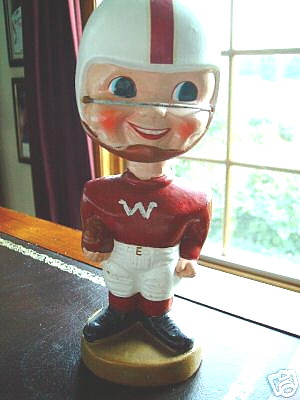
Last phonies:
Michigan State Real Face. Phony decals, as I list in my price guide only a handful of colleges were made in this style. $232 on Ebay. At right is a real example of a realistic face doll.
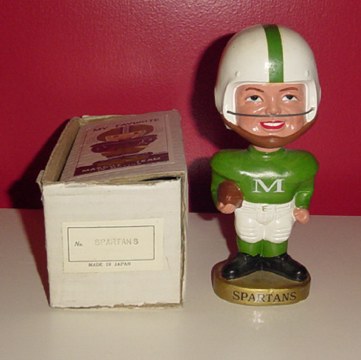
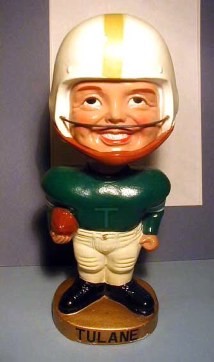
Left: Phony Wisconsin Square Base, sold for $427. Right: Real Square base from my price guide
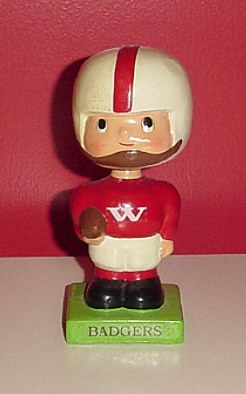
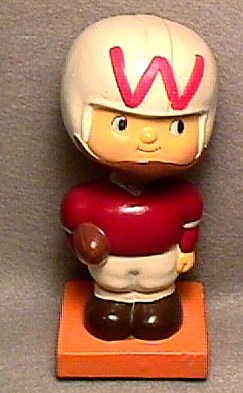
Check underneath the base
If you see a beautiful doll with gem colors and gloss and no flaws, it would stand to reason that the doll has been very well taken care of over the years, possibly behind glass or packed away. If that's the case you would expect the bottom of the base to be relatively clean and new looking. If I see a "gem mint" doll being offered and the bottom of the base is all nicked and scraped up I go the other way..
Check the decals relative to the rest of the doll.
Other than some creative touch ups, it's impossible to restore original decals. If the original decals are faded, chipped, dirty, darkened, etc and the rest of the doll is in beautiful gem condition I would explore further. Decals are funny things so this is far from foolproof but it should at least be considered. See more regarding decals in the "Professional Cleaning" section.
Professional Cleaning
"Professional Cleaning" is a type of restoration. Despite the protests of some, in my mind a doll that has been professionally cleaned is certainly not an original doll.
Professional cleaning is a process where a restorer take a dirty doll, sprays or brushes on a very astringent cleaner which bleaches and whitens the paint. It's absolutely amazing the amount of grime and staining that washes off. The result is a bright white doll. If that's all that was done I would agree that the doll would definitely still be considered original, all you've done is cleaned it..
The problem is, in almost every case the cleaning solution not only removes the stains and dirt, it also strips off much or all of the original shellac, leaving the doll looking very white but also lacking gloss. In order to shine it up a clear coat is sprayed back on, the end result being a glossy gem looking example. The act of adding the clear coat constitutes an addition and I would no longer consider it an original doll.
A couple of notes on professionally cleaned dolls:
How to spot a professionally cleaned dolls-
Too White ?
Look for dolls that appear just a bit "too white". While it is possible to find original gem mint dolls with snow white coloring, they are quite rare and don't come long often. Most dolls, even those considered "Gem Mint" will have some natural darkening to the white uniforms, however minor it might be. When I see dolls on EBay that are bright white I'm always initially a bit suspicious, you should be too. Don't get me wrong, the dolls are beautiful and would look great on your shelf, nothing wrong with buying them, just beware of what you're getting.
The 3 dolls below appeared as a lot on EBay. My initial reaction was they appeared to be "too white".. They've either been cleaned or they are truly rare examples.. Looking at the 3rd picture it would appear that the rims are just a bit too smooth to be original. Seldom do you see a Mays rim with it's flat, rough border having perfectly even paint. If I were to bid on these I'd do so figuring that they were restored.
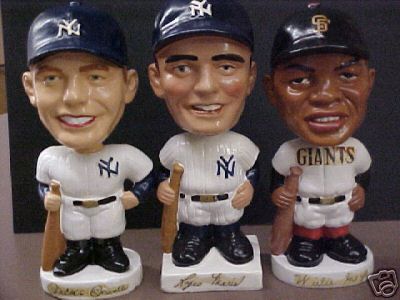

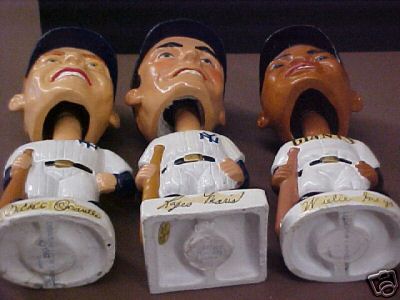
Darkened or Faded Decals
As I mentioned above, dolls that have been cleaned can often be spotted by looking at the decals. While you may be able to lightly clean a decal up a bit with some water or mild solution it's pretty much impossible to get them looking like new again. If you see nice bright white shiny dolls with tattered, dirty or stained decals you would want to think twice.
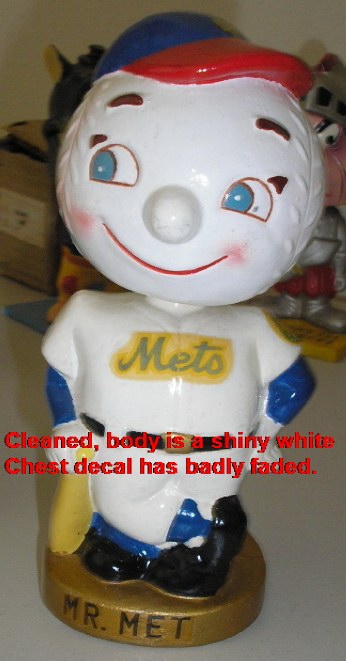
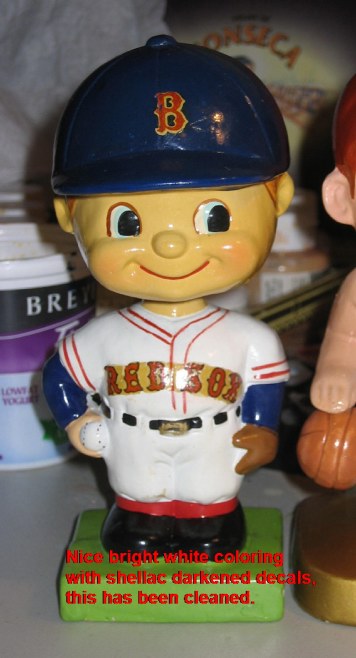
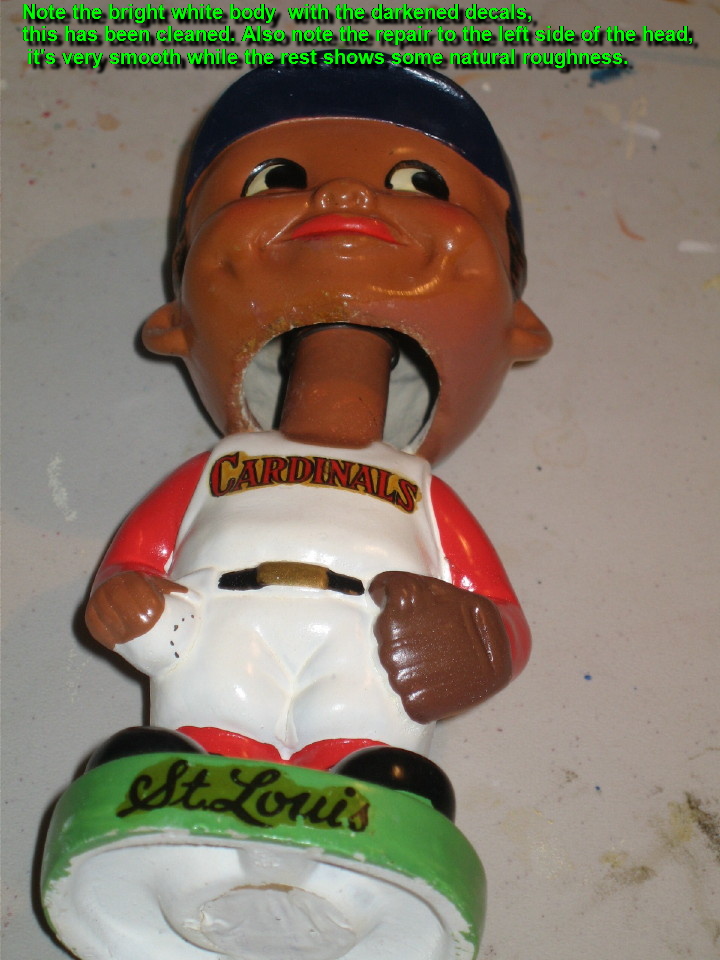
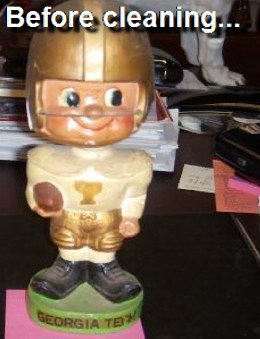
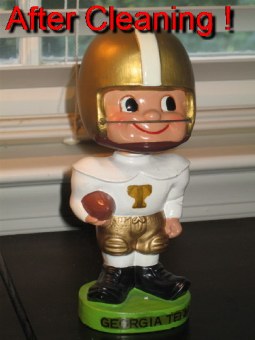
Perfect Example
Here's a near perfect example of an original "Gem" doll on the left, and a professionally cleaned "gem" doll on your right. Hopefully you can see the slight difference in coloring on your screen. The doll on your left has a nice glossy "soft white" coloring, it was probably just a shade whiter 45 years ago but time has softened the color just a hint. Doll on your right has been professionally cleaned and is a shiny "bright white". Both look beautiful and would enhance any collection but the doll on the left would be "original" while the doll on the right is "restored". If originality is not important to you either doll is great but I think a dealer needs to let you know the difference.
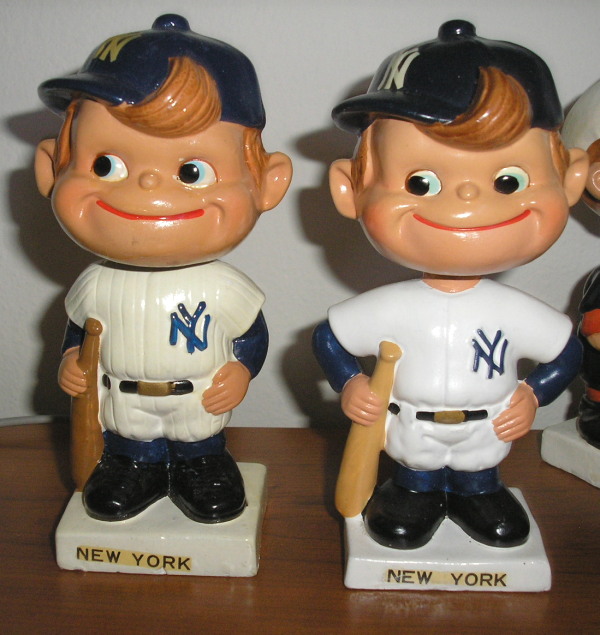
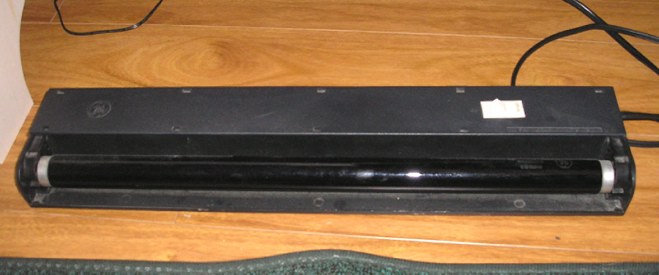
Before I started the Nodder Exchange 6 years ago I went to a Poster store and picked up this blacklight for $15. It's proved to be the best business investment I ever made and is an invaluable tool for Bobbing Head Collectors.
How to use it:
Darken the room, the darker the better. Turn on the light and shine it at the doll. Easy so far..
What to look for:
Take a doll, or a few dolls that you are sure are original, perhaps some original dolls that you bought from me. Shine the light on them, the first thing you will notice is that the original paint on these dolls "absorb" the light. I'm not sure of the scientific terms but the best way I can describe it is that it appears you are "seeing into the paint". Shine it on a few original dolls and you'll be able to tell exactly what I mean.
If you have a doll that you know has been restored line that up next to the original dolls and turn on the light.. The difference will be readily apparent. The paint on the doll that has been restored will "reflect" the light and will shine back at you. This is the result of new paint added or new clear coat that was sprayed on the doll when it was restored.
Spot repairs, such as the rim, shoulder, etc. are very easy to spot. For example, if the bottom left side of the rim has been repaired, the paint will absorb the light on the face until it reaches the spot that has been redone. The restored area will glow back a purple like color and will be extremely easy to spot. Any area that has had something added will reflect back.
Some dolls that have been professionally cleaned and sprayed as described earlier are a bit more subtle but are apparent with practice. The doll will display a light even glow throughout, reflecting the light rather than absorbing it. When you compare it to an original doll it's easy to tell the difference.
The act of spraying a doll with clear coat will often mask the repair work under a black light, sometimes making it difficult to tell exactly what has been done to it. It may be hard to tell the extent of the repairs if it has been sprayed however I don't worry to much about that since the act of spraying it constitutes restoration. In my mind the extent of the work is not the major issue, the doll is either original or it's not.
"Practice makes perfect"
Using a black light proficiently takes some time and practice. I know I drove myself crazy in the beginning, I'd look at a group of dolls a couple of times . I'd look at them once and think they were all repaired, looked at them a 2nd time and thought they were all original ! Of course I had no idea what I was looking for and this little primer should give you a big leg up.
I found the best way to become an expert was to practice.. I picked up several cheap beat up dolls and experimented. Take a beat up doll that is original and put it under the light, you'll see that the paint absorbs the light throughout. Add some touch up paint to an area of the doll and light it up again, you'll see the difference. Take a black marker or black paint and touch up the feet, again under the light the spot that was touched up will be very visible. Get some clear coat and spray one side of the doll (either the front or the back). When you put it under the light the original side will absorb the light, the side with the spray will have a light glow as it reflects the light. It might cost you a few $bucks now but could save you $1,000's down the road.. The more you practice the easier it will be to tell the difference.
Tricky Issues
I've probably put over 6,000 dolls under the black light since I started using it (basically every doll that goes through here goes under the light) and even now I occasionally have a doll that I have questions on. Some of the trickier one's include:



Please, please read this!!!
Do's
It's about time we stop being sheep led to the slaughter and start fighting back. Write letters, complain to EBay, Paypal, the Better Business Bureau, whatever you need to do. If an autograph dealer is caught selling phony or forged autographs he gets drummed out of the hobby and probably ends up getting sued. If an art dealer sells forged or fake works of art and gets caught he probably gets prosecuted and goes to jail. In our hobby those dishonest dealers make a lot of money with no consequences.
Don'ts
As an example, not too long ago I picked up a collection of 30 nice dolls from a collector who needed to sell. Out of the thirty, nine had some degree of restoration, ranging from touch ups to major repairs. We sold the dolls, described honestly and he was thrilled with the bids they received. Another example, I've auctioned 15 Mantles of various molds over the last 3 years, 10 had some restoration, 5 were original. The only thing rarer than seeing a "Gem Mint" Mantle for sale is seeing one with nicks and cracks... I know of one guy who has restored over 25 Mantles himself in the last year or so.
Hi John,
I'm glad to offer a few notes on what to look for in terms of suspected repair work. As you know, even though I do some private restoration, I hate to see people get ripped off. That's why I consign to you as I know you'll be upfront with your descriptions.
As I learned from you, the blacklight is your best friend--a $15 investment at Wal-Mart can save you from bad deals when you buy a nodder and also from bad surprises (and embarrassment) when you go to sell. A little bit of practice on some nodders that you know are good as well as nodders that you know to be repaired and you will be well on your way. I'll leave it to you to provide blacklight instruction.
The easiest way to make a nodder look nicer is to clean it up. Using a damp cloth or mild cleaner is not considered to be 'repair' as it does not penetrate or disturb the original lacquer finish. However a badly stained (e.g. with tobacco) nodder will sometimes be cleaned by stripping the lacquer finish with a harsh cleanser (while protecting the decals) and recoating with a clear finish. This is known as 'professional cleaning' and can produce a beautiful like-new doll [Note: please DO NOT try this at home, it requires the right products and much experience to get the doll clean, with valuable decals intact, with proper finish, etc.]. The telltale sign of a professional cleaning is shown on the attached photos of a Red Sox color base and a Cards blackface. You'll see the decal with the dark yellow signs of staining but the uniform showing a beautiful near-white. So the uniform is perfectly like-new and the decal is badly yellowed...hmmm...just think about how it could have gotten that way and this trick will be easy to remember.
Since the blacklight is sometimes inconclusive, other visual inspections are often needed. We all know that the head rim is the most-often-damaged area so this is the first place to look for repair. Usually with an original doll the flat edge of the head rim (and the paint) is irregular, i.e. not perfectly smooth coming out of the mold; meanwhile repaired rims are usually smoothed and painted thoroughly. Again referring to the Cards blackface photo you'll see that the left edge facing you is irregular (i.e. 'original') whereas the right side has been repaired, smoothed and touched up. Usually an entire rim will be reworked but this doll with a spot repair offers a nice contrast of original vs. repaired.
Another obvious place to visually look for repairs is up inside the head. Most restorers do not bother to also cosmetically clean up the inside of the head--the restorer is not trying to hide his work and it is the exterior that matters. However be aware that some restorers have been known to also restore the inside cosmetically--which looks nice, but don't be lulled into a false sense of security by a nice-looking inside.
At the margins I'd say trust your instincts. After you see enough nodders and get a feel for legitimate 'mold flaws' you'll gain confidence in your sense of 'what looks right'. Some things such as color variations are quite legitmate as original paints were often applied unevenly, the lacquer coats were often uneven, etc. Same for dings and dents and mold flaws. But if you see something resembling a crack with paint over it (such as around the ankles) you can be pretty sure it's a shoddy repair. If it looks like a duck...
Last, but most importantly (especially for the newer collector), as much as possible buy from someone you trust and rely on their experience and honesty. We all started out our collections with 'gem original' dolls, got a few years into it, learned these tricks and discovered that many of these 'originals' were original frauds. Asking around about other people's experience with various sellers can be invaluable.
Another thing we all know is that new collectors are the lifeblood of the hobby and confidence in knowing what you're buying is what allows all of us to stretch when you 'see the real goods'. So I hope this is useful to your readers.
Best Regards, Dave Graziano